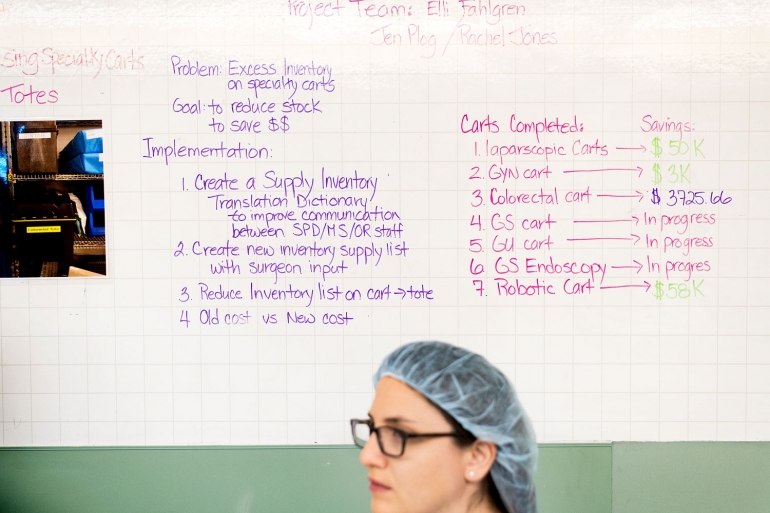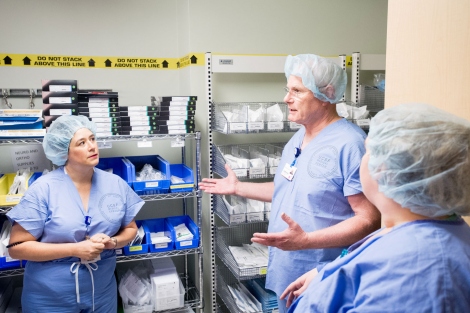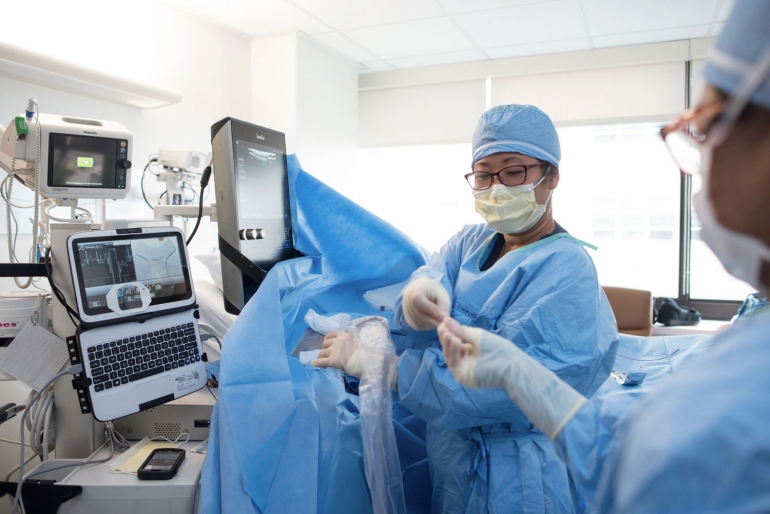The Making of a World-Class Health System: How UCSF Health Excels Amid Today's Industry Demands

At 9 a.m. sharp on a Thursday, a team of clinic providers and administrative staff at UC San Francisco’s Spine Center gathered around a series of data-drenched posters tacked to the wall outside a row of exam rooms.
“The good news is we’ve surpassed our targets in two areas of improving the patient experience, and we continue to show progress week by week,” said Omar Flamenco, practice manager for the neuro-spine clinic. “We’ve done the best this month we’ve ever done historically, but demand has also increased, so we need to continue improving our referral process. We’re not going to settle for what we have right now.”
This type of meeting, called a huddle, occurs daily across more than 70 outpatient clinics at UCSF Health, bringing every employee into the process of constantly looking for ways to do things better.

Efficiencies are key for health care organizations. In the last decade, a historic revolution has gripped the industry, and with it, a continuous stream of challenges has emerged. Health care providers across the country must contend with higher costs and lower reimbursements, while the individuals, employers and government programs that pay for services rightfully expect more patient-centered, effective and affordable care.
“I think to get to the top and remain there, you must have an unrelenting focus on the fundamentals – the quality and safety of the care you deliver, the experience patients have, and the cost of what it takes to provide services in today’s health care market,” said Mark Laret, UCSF Health’s president and CEO. “We have been aggressive on every one of those fronts, and we just strive to keep getting better.”
The focus has paid off: UCSF Medical Center, the system’s flagship hospital, is for the second year the best hospital in California, according to U.S. News & World Report. In addition, UCSF Benioff Children’s Hospitals rank nationally in 10 pediatric specialties and are the best in Northern California in six practices.
Fostering a Culture of Continuous Improvement
The huddle at the Spine Center is an example of UCSF Health’s implementation of ‘Lean’ management, which, according to David Morgan, vice president of ambulatory services and faculty practice operations, has brought about a dramatic shift from a traditional command and control leadership structure to a more collaborative, team approach.
“Lean teaches you that the goal is to have every single employee be a process improvement expert constantly looking for ways to do things better,” Morgan said. “What we try to instill in folks is that they’re always going to be working on improving. This is a journey, and we will celebrate our wins along the way.”


Simply put, Lean management is about creating more value for customers while minimizing waste.
It is a data-driven approach focused on setting and achieving goals through clearly defined process improvements, driven by the scientific method. For an organization like UCSF, known for pioneering evidence-based care, Lean is the perfect complement with its innovative, evidence-based business philosophy.
Lean process improvement tools now inform many operational decisions at UCSF Health, including how medication is delivered, how patients are discharged, and how bills are submitted, to name a few.
The end goal is always the same – improving quality and the patient experience while reducing cost. It is what Laret refers to as the “holy grail in health care.”
According to Cynthia Chiarappa, UCSF Health’s vice president of administration, the Lean approach pushes organizations to shift their mindset and adopt a culture of continuous improvement. This shift began three years ago at UCSF Health with the creation of its "True North" and strategic pillars, defining the organization’s overarching goals and priorities.

“What we are building is a management system that enables us to have accountability and responsibility where we most need it. This aligns people to purpose and enables them to improve their work,” Chiarappa said. “It’s this mindset that you try something, you learn from it, and then you adjust. You don’t just come to work to work, you come to work to improve the work.”
There are currently 30 value improvement initiatives underway across various units at UCSF Medical Center – from projects focused on minimizing drug waste to improving supply chains to reducing the length of a patient’s stay.
The Power of Partnership
Of all the challenges associated with today’s health care landscape, none is more potent than the downward pressure on reimbursements combined with the upward pressure on costs. This challenge has generated a massive consolidation within the industry, and UCSF Health has followed suit, explained Joshua Adler, MD, UCSF Health’s executive vice president for physician services.
Since the release of its most recent strategic plan in 2014, UCSF Health has effectively shifted from operating as a standalone academic medical center to a fully integrated comprehensive health system. Its ever-increasing lineup of affiliate hospitals and clinics includes John Muir Health, Dignity Health Bay Area, Washington Hospital Healthcare System, Golden Gate Urgent Care, Hospice by the Bay, Sonoma Valley Hospital and Marin General Hospital.
The reality is you just can’t do it all on your own. You can’t meet industrial level production standards by building a car in your garage, and that’s a lot of what health care has been.
“The reality is you just can’t do it all on your own. You can’t meet industrial level production standards by building a car in your garage, and that’s a lot of what health care has been. People want things to be reliable and consistent and you can really only make that happen in systems of care,” Adler said. “These systems also need to serve much larger geographies to help ensure patients can get most of their care close to home. The future of health care in America will be large, integrated systems, and this is our version of it.”
Growing the UCSF Health enterprise through collaborative partnerships has enabled the organization to establish a network-wide quality framework and build upon a number of cutting-edge programs, while scaling other operations to reduce costs.
In addition to partnering with community hospitals, UCSF Health has spearheaded the development of large health care provider collectives known as clinically integrated networks, or CINs. CINs unite community- and private practice-based physicians with a top-tier provider in UCSF, giving patients access to everything they need – from routine to highly specialized care – from the moment they enter their local practice.

Jacob Johnson, MD, a San Francisco-based otolaryngologist, was among the first specialists in private practice to join UCSF Health’s CIN, and has seen the mutual benefits of this type of partnership firsthand. By gaining access to UCSF’s electronic medical record system, for example, Johnson’s practice can utilize cutting-edge technology while making seamless referrals to UCSF specialists when needed.
“In most models when you partner with someone, they want you to do everything at their institution, but this isn’t the case with UCSF,” Johnson said. “UCSF wants patients to stay close to home and do what is best for each individual based on cost, access and quality. That’s really forward-thinking.”
Putting People First
UCSF Health’s forward-thinking extends far beyond its approach to partnerships and business operations. More than 16 years ago, UCSF Medical Center adopted a core set of values known as PRIDE, or Professionalism, Respect, Integrity, Diversity and Excellence. These values, which have since been adopted across UCSF, serve as a moral compass for every employee and have resulted in a broadly diverse workforce.
“I personally believe that a major reason our medical school is the top public recipient of NIH dollars and our medical center is the best in the state is because of our longstanding embrace of diversity,” Laret said. “I think if people feel they have a safe environment where they can really contribute and make a difference, they will do well. And that’s why UCSF has succeeded.”

Building upon this commitment to a diverse and engaged workforce, Laret and his leadership team have made a concerted effort to better recognize the outstanding work of employees at every level of the organization. Through initiatives like the ‘Great Catch for Patient Safety Awards,’ employees ranging from custodial staff to nurses are regularly honored for their shared commitment to achieving excellence.
“A great health system is not about the facilities. It’s not about the equipment. It’s about the people who choose to work there and how they approach their work,” Laret added. “People at every corner of this organization take ownership and try to make things better. They are the backbone of UCSF Health.”
A great health system is not about the facilities. It’s not about the equipment. It’s about the people who choose to work there and how they approach their work.
President and CEO, UCSF Health
Laret’s recipe for success has enabled UCSF Health to grow into a more than $4 billion clinical enterprise, with affiliate hospitals throughout Northern California. Over the past three years, UCSF Health has seen patient satisfaction ratings climb, while negative safety incidents and overall costs have continually decreased.
The ongoing success of UCSF Health, explained Laret, is a direct result of the organization’s unwavering commitment to achieving excellence, an adept understanding of how health care providers operate most efficiently, and a true appreciation of its most important asset – the people who do the work.
“The biggest challenge we have in health care is that we have long been a very labor-intensive business,” Laret said. “Health care is the most intimate, personal part of people’s lives, and we want to bring the human touch to everything we do.”